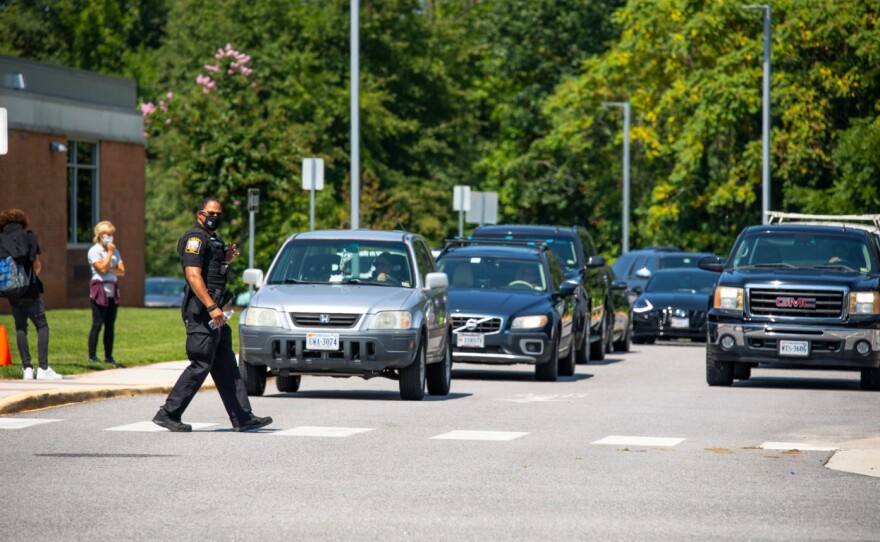On a chilly December morning in Lynchburg, Kim Simon kicked off a weeklong training for law enforcement officers who were recently hired to work in Virginia schools.
Simon is the school resource officer training and program coordinator for the Virginia Center for School and Campus Safety. The center was created by the General Assembly more than 20 years ago, following the school shooting in Columbine, Colorado.
“Up until three and a half years ago, I was in your very shoes,” Simon told the officers. “I was an SRO.”
The training has been mandatory for all Virginia school resource officers since July 2020, although Simon said the majority of officers attended voluntarily before that.
This December training date was added to the calendar specifically because of the record amount of state grant funding — more than $20 million — recently awarded to help localities hire full-time school resource officers and school security officers. School resource officers are members of local law enforcement, while school security officers are not.
The funding is part of a push by Gov. Glenn Youngkin, who announced his desire to have a law enforcement officer in every public school statewide during his state of the commonwealth address last January.
Many officers at this December training were from Southwest Virginia, where a significant number of localities received the FY23 grant funds.
About two-thirds of localities that received grants during the first two rounds used the funds to place more police and security staff in elementary schools. More than 80% of the funds went to hire more police — who are armed — while the rest were used to hire security officers — who are not armed.
Bedford County received the most funding for police in schools from the first two grant rounds: more than $1 million dollars. The county’s sheriff, Mike Miller, applied for the grant to pay for 14 new officers, one at each elementary school in the district. He said they’re still hiring for about half of the positions.
“We want our children to feel as safe as possible. And we want our staff to feel as safe as possible,” Miller told VPM News. “If that means putting a deputy in every school, then that's what we do.”
Roanoke City Public Schools received funding for 13 school security officers — 12 at the elementary level and one at the middle school level. Chris Perkins, who helped apply for the grant as the district’s chief operations officer, said the officers’ primary duties will include making sure doors are locked and visitors are vetted, as well as coordinating all safety drills and fire inspections.
Following the Uvalde, Texas, shooting earlier this year, Perkins was working on updates to the district’s safety plan when the opportunity for the grant came up. He said increased school security is one of many priorities that surfaced through a series of town halls and surveys with the community.
“Anytime there is a national, local or regional incident involving safety involved in a school, there's always … and I won't call it panic … but there's angst that is created,” Perkins said. “Because no one ever wants to go through a tragedy with children involved.”
‘It’s better to be prepared’
The first day of the school resource officer training in Lynchburg included a presentation on crisis response that detailed lessons learned from other high-profile shootings like those in Newtown, Connecticut, and Parkland, Florida. For example, the importance of locked classroom doors, as well as training for school staff about how — and when — to call for a lockdown and communicate it quickly.
Richard Goodman, who started as a school resource officer in Roanoke city elementary schools this past fall, said this was welcome information. He’s worked in law enforcement for more than 30 years.
“We don't ever want to take for granted that it won't happen where we are,” Goodman said. “So, it's better to be prepared and to train, and to keep everybody's mind fresh and alert to possible situations.”
Deputy Callie Dungan is also a new school resource officer in Franklin County. Her county received state funding for six SROs spread among the district’s 12 elementary schools. Dungan started in her new role at the beginning of the school year and is splitting her time between two elementary schools.
“During one of the lockdown drills, it was literally what hit me full force of … this is where I'm supposed to be, this is the mama-bear work that I'm supposed to be doing right now,” Dungan said.
Trainers emphasize prevention, youth development
The training didn’t exclusively focus on threat assessment and crisis response, however. Throughout the week, officers also heard from experts about suicide prevention, youth brain development and de-escalation, among other topics.
“We do not want our educators or our SROs to lose focus of the other types of crises that happen in a school because all they're thinking about is, ‘I'm worried about the next person who might come in and shoot up the school,’” said James Christian, manager of the Virginia Center for School and Campus Safety.
For example, he said the bulk of threat assessment cases in Virginia schools involve suicide. A threat assessment is a fact-based process of appraising and observing behaviors to identify potentially dangerous situations, to investigate and assess them, and address them. All public schools in the state are required to have threat assessment teams, which include SROs at schools that have them.
Simon said the most successful school resource officers are more like chess players than checkers players: They’re able to slow down, look at the big picture and analyze a situation before acting.
“They're successful, in part, because they recognize the value in prevention, they understand the difference in how the [youth] brain functions,” Simon said. “When you're working with young people, it's imperative that you have the ability to regulate your emotions and to think about what benefit your actions — or what potential difficulty your actions — are going to have, not just in that moment, but down the road in the long run.”
She reiterated that youth should only be arrested in extreme circumstances and said officers should not be involved in school discipline.
“They're not trained for it, it's not part of their role or responsibility,” Simon said. “It becomes a conflict of interest when you start having an individual who's tasked with law enforcement also crossing over into discipline.”
Still, not all Virginia school districts want police in schools. And some — like Charlottesville City Schools — have recently taken steps to remove them.
Constance Lindsay is a professor and researcher at the University of North Carolina at Chapel Hill. In a prior role at the Urban Institute, she analyzed studies from across the country about the impact of police in schools.
“Our takeaway was mixed, I guess you can say,” Lindsay said.
One study out of North Carolina found that police presence in schools can lead to declines in violent incidents — like attacks on staff or other students — but increases in arrests and student discipline, especially in schools with students who are predominantly Black and Hispanic.
“I think we just have to ask some really hard questions about what do we expect police to do? What type of training are they getting? Are there other things that we could do to make school safer? And what does it mean for school to be safe?” Lindsay said.
At least for now, it’s up to individual school districts in Virginia to decide if they want police in their schools. Legislation to mandate police presence in every school building failed last year.





